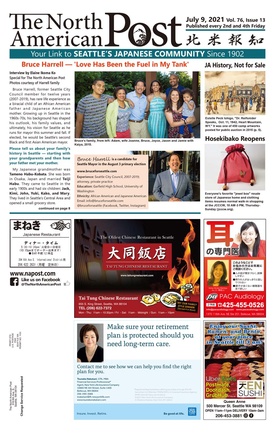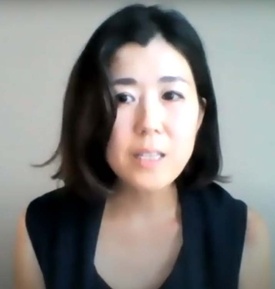90% of the pages are in English
The oldest Japanese newspaper in America is The North American Post, based in Seattle, Washington. However, when it was first published, its name was The North American Times, and its first publication dates back to 1902. The paper was established in Seattle, where the Japanese community has long been formed, by its first publisher, Kiyoshi Kumamoto, and several other first-generation Japanese. Until the war, the paper was a daily Japanese-language paper with a circulation of about 12,000 copies. It had correspondents not only in Seattle, but also in Portland, Los Angeles, San Francisco, Spokane, Vancouver, and Tokyo.

However, during World War II, the newspaper was closed in March 1942 after its executives were taken away by the FBI. When the core staff returned to the city, the political tone of "Hokubei Jiji" was toned down and the newspaper was relaunched as "Hokubei Hochi" with a new concept of a notice media for the community. After that, the number of subscribers continued to decrease along with the decline in the population of first-generation Japanese-Americans who read Japanese, but in 1988, Tomio Moriguchi, then president of Uwajimaya, which operates a Japanese food market in the Northwest region centered on Seattle, stepped up to become the publisher. This is how the long-standing Japanese newspaper was able to survive. Then, in response to the change in generations of Japanese-Americans, it began distributing the newspaper for free in 2005, and since 2017, the English section has been significantly increased, and now 90% of the paper is in English, reborn as a newspaper targeting Japanese-Americans and Asian-Americans of the third generation and beyond. It is currently published twice a month with a monthly circulation of 15,000 copies.
Meanwhile, in 2012, the company acquired Soy Source, a Seattle-based Japanese information magazine that was first published in 1992. As a result, North American Post Publishing Inc. became the publisher of two media outlets: The North American Post, aimed at Japanese Americans, and Soy Source, aimed at Japanese people.
Misa Murohashi, the current editor-in-chief and general manager of the Hokubei Hochi, told us this history. When I asked her what kind of articles are popular, she replied:
"The third-generation Japanese are now in their 50s and 60s and approaching retirement age. Now that they've finished working, their next interest is their family roots. That's why articles about Japanese family history are particularly popular. It's not hard to find subjects for such articles. The Japanese community in Seattle is tight-knit, and everyone knows each other. Prefectural associations in Hiroshima and Kumamoto, Japanese churches like Seattle Betsuin Buddhist Church, and non-profit organizations like the Japanese Cultural Center of Washington and Densho are particularly active, and they keep people connected. During the COVID-19 pandemic, events like New Year's parties were canceled, but I would normally be happy to participate in such events. The Japanese Cultural Center of Washington uses the school building of a Japanese language school founded in 1902 to pass on Japanese culture to the younger generation. Densho is an organization that digitally preserves video, photographs, old newspapers and other materials that record oral family histories."
Building a bridge between Japanese people and Japanese descendants
Articles about Japanese-American family history are translated into Japanese and reprinted in the aforementioned sister paper, Soy Source. "The North American Post is a publication targeted at Japanese-Americans, and Soy Source is a publication targeted at Japanese people, and we aim to be a bridge between the two by exchanging information between the two. The Japanese American community and the Japanese community seem close, but they are far apart. I think the main reason is the language barrier. By telling Japanese people about the history of Japanese-Americans, and letting Japanese people know about people who came from Japan to America and are making a name for themselves, we want to remove even a little of the barrier between them. I think it's meaningful to translate articles written in English into Japanese and Japanese articles into English to let people know not only about each other's history but also about the problems we are currently facing," says Murohashi, who says he wants to continue doing his best to bridge the gap between the communities by reprinting articles.
However, the problem remains financial. "Revenue from advertising on the paper and subscription fees alone have become difficult to come by these days, so we have been looking for ways to make money outside of media. One business that has been particularly successful in recent years is our travel to Japan business, which targets Japanese Americans. We started this about 10 years ago, and over the past few years we've established an operating routine, seen an increase in repeat customers, and are now able to operate with a solid profit. Because the media business has a high level of public nature, I think it's always a challenge to balance contributing to the community with management that is conscious of profit. As general manager, I am also conscious of managing the media in a way that can secure profits, in order to continue the history of the North American Post."
An NPO called the North American Post Foundation was established in 2011 and is currently working on a project to digitally archive old articles and preserve and pass on the history of Japanese Americans in the Seattle area. "The North American Post Foundation will carry out non-profit activities such as preserving the history of Japanese immigrants and passing that history on to younger generations with support from the government and donations from the community," says Murohashi.
As the oldest Japanese newspaper in North America, will the newspaper continue to stick to paper printing in the future? "Internet information and paper information have different characteristics. With the Internet, readers can obtain only the information they want by using keyword searches, etc. However, with paper media, by picking up a newspaper, information can be conveyed that the reader did not intend. I believe that there is still a reason for the existence of paper media."
And in 2022, North American Post will celebrate its 120th anniversary. "As part of our 120th anniversary planning, we started a series of articles in May called ' The History of Japanese Immigrants in Seattle as Seen Through North American Current Affairs .' A Japanese person whose grandfather was a Japanese-American living in Seattle has written about pre-war Japanese-American society after reading archived articles from North American Current Affairs. The original articles, which were written in Japanese, have been translated into English in collaboration with Discover Nikkei, a project of the Japanese American National Museum. We also hope to hold more online seminars on Japanese American history in the run up to our 120th anniversary."
Murohashi previously published a magazine in Seattle called "Ibuki" that introduced Japanese culture in English. After a period of devoting herself to raising her children, she became editor-in-chief and general manager of "Hokubei Hochi" four years ago. We hope that she will continue to oversee both the management and editorial aspects of the magazine while also contributing to building a bridge between the Japanese-American and Japanese communities.
Official website: North American News
・『 Soy sauce 』
© 2021 Keiko Fukuda







